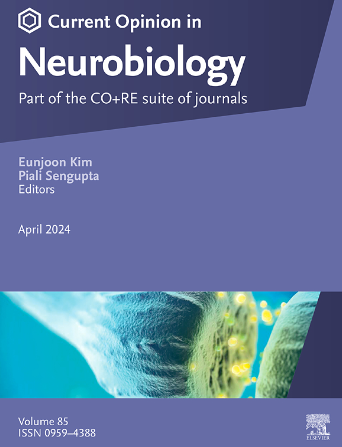指定小白蛋白中间神经元神经支配特性和可塑性的分子程序
IF 5.2
2区 医学
Q1 NEUROSCIENCES
引用次数: 0
摘要
Parvalbumin-positive (PV)中间神经元是一类快速尖峰gaba能中间神经元,在神经元回路中控制增益控制和神经元信号传播的时序。pv -中间神经元具有显著的时间精度,能迅速将兴奋性输入信号转化为强抑制性输出信号。在皮质回路中,这提供了关键的前馈和反馈抑制。鉴于pv -中间神经元在指导神经元回路功能方面的重要作用和独特功能特征,pv -中间神经元已成为揭示神经元突触特性规范背后的分子机制的优秀模型系统。此外,对pv -中间神经元的研究发现了神经元可塑性的新机制,因为pv -网络在响应感官经验和学习过程的变化时迅速适应其连通性。在这篇综述中,我们将整合最近关于指导谷氨酸突触在pv -中间神经元上形成的不同突触蛋白复合物的研究,并讨论动态调节pv -中间神经元功能的转录程序。本文章由计算机程序翻译,如有差异,请以英文原文为准。
Molecular programs specifying properties and plasticity of parvalbumin interneuron innervation
Parvalbumin-positive (PV) interneurons, a class of fast-spiking GABAergic interneurons, govern gain-control and the timing of neuronal signal propagation in neuronal circuits. With remarkable temporal precision, PV-interneurons rapidly transform an excitatory input signal into a strong inhibitory output. In cortical circuits, this provides critical feedforward and feedback inhibition. Given their important roles and unique functional features in instructing neuronal circuit function, PV-interneurons have served as an excellent model system for uncovering molecular mechanisms underlying the specification of neuronal synapse properties. Moreover, studies on PV-interneurons led to the discovery of novel mechanisms of neuronal plasticity as PV-networks rapidly adapt their connectivity in response to changes in sensory experience and during learning processes. In this review, we will integrate recent work on the distinct synaptic protein complexes that instruct glutamatergic synapse formation onto PV-interneurons and discuss transcriptional programs that dynamically adjust PV-interneuron function.
求助全文
通过发布文献求助,成功后即可免费获取论文全文。
去求助
来源期刊

Current Opinion in Neurobiology
医学-神经科学
CiteScore
11.10
自引率
1.80%
发文量
130
审稿时长
4-8 weeks
期刊介绍:
Current Opinion in Neurobiology publishes short annotated reviews by leading experts on recent developments in the field of neurobiology. These experts write short reviews describing recent discoveries in this field (in the past 2-5 years), as well as highlighting select individual papers of particular significance.
The journal is thus an important resource allowing researchers and educators to quickly gain an overview and rich understanding of complex and current issues in the field of Neurobiology. The journal takes a unique and valuable approach in focusing each special issue around a topic of scientific and/or societal interest, and then bringing together leading international experts studying that topic, embracing diverse methodologies and perspectives.
Journal Content: The journal consists of 6 issues per year, covering 8 recurring topics every other year in the following categories:
-Neurobiology of Disease-
Neurobiology of Behavior-
Cellular Neuroscience-
Systems Neuroscience-
Developmental Neuroscience-
Neurobiology of Learning and Plasticity-
Molecular Neuroscience-
Computational Neuroscience
 求助内容:
求助内容: 应助结果提醒方式:
应助结果提醒方式:


